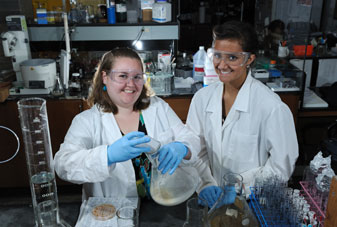Doctoral student wins prized NSF graduate fellowship

Amanda Waters (left) shares her enthusiasm for chemistry with local high school student Alexis Fullmer.
Ph.D. student in pharmacognosy is the University of Mississippi's first graduate student to receive a fellowship from the National Science Foundation Graduate Research Fellowship Program since the late 1990s.
The fellowship provides 24-year-old Amanda L. Waters with an annual stipend of $30,000 for up to three years, for a total of $90,000.
Her selection was based on her "outstanding abilities and accomplishments," as well as her "potential to contribute to strengthening the vitality of the U.S. science and engineering enterprise," said James Lightbourne, director of NSF's Division of Graduate Education, in a letter informing Waters she was a fellowship recipient.
"I am delighted to learn that Amanda was selected to receive an NSF Graduate Research Fellowship," said Maurice Eftink, UM associate provost and Graduate School dean. "Amanda is shoulder to shoulder with some of the nation's top doctoral students."
Waters is entering the third year of a "straight" Ph.D. program, meaning she is pursuing a doctoral degree without first earning a master's. She obtained her Bachelor of Science in chemistry from the University of Oklahoma, where she began her natural products research as a freshman and graduated with a 4.0 grade-point average and honors.
In the UM School of Pharmacy, she is conducting research on a group of compounds called karlotoxins, which have been associated with large fish kills around the world. The toxins are produced by Karlodinium veneficum, a dinoflagellate (type of algae) able to grow using photosynthesis or by using the toxins it produces to kill other algae so it can consume them.
"They're a worldwide problem," said Waters, who is developing and simplifying the analytical methodologies needed to determine the toxins' exceptionally complex structures.
This spring, she reported results of her work at the 38th annual Medicinal Chemistry and Pharmacognosy Meeting-in-Miniature in Houston, Texas, and walked away with the Robert A. Magarian Outstanding Podium Presentation Award.
"This is a notable achievement and one that reflects positively on Amanda, her mentors, her department and the School of Pharmacy," said Barbara G. Wells, the school's dean. "We commend her efforts to excel, which will serve her well throughout her academic and career endeavors."
Waters is conducting her research in collaboration with UM pharmacognosy professor Mark T. Hamann and Allen R. Place, a professor at the University of Maryland Center for Environmental Science's Institute of Marine and Environmental Technology. Place, who recently received a grant from the National Oceanic and Atmospheric Administration to prevent and control harmful algae blooms in the Chesapeake Bay area, collects samples of algae and the toxins they produce from around the world and shares them with Waters for analysis using nuclear magnetic resonance spectroscopy.
A team of researchers in the United Kingdom discovered karlotoxins in the 1940s while growing dinoflagellates as a food source for an oyster restoration project.
"They spent nearly a decade studying the toxins' pharmacology but could not elucidate their structures with instrumentation available at the time," Hamann said.
Interest in the toxins waned until researchers found that Karlodium veneficum and the suite of toxins it produces were present during massive fish kills in the 1990s.
"Even with the tools currently available, it took us another decade to produce, purify and solve the toxins' complete structure," Hamann said.
Place, Hamann and three other scientists unraveled the complete karlotoxin-2 structure and published a landmark paper on their work in the Journal of the American Chemical Society in 2010 (132, 3277-3279). The paper was cited by the Faculty 1000-Biology, which grasped its broad implications for research on human health and environmental changes.
Waters' role, and the basis of her NSF fellowship application, is developing methods to solve these types of complex chemical puzzles simply, quickly and with small samples of toxins.
"Amanda brings exceptional talent and enthusiasm to the project," Hamann said. "Her academic capabilities are rare and bridge the fields of chemistry, biology, physics, and the environmental and computational sciences. Without her exceptional talent and infectious enthusiasm, projects like this would wither and die."
Building on the 2010 landmark paper, Waters has already elucidated the structure of karlotoxins produced by algae first isolated in the 1950s.
"The original investigators froze their samples in a repository, Al (Place) cultured them with assistance from the Plymouth Marine Laboratory, and Amanda helped elucidate the structure," Hamann said.
They also learned that the molecules vary slightly, depending on the region of the world from which they are collected, another reason why Waters' analytical tools are so important. So, too, is the growing frequency of blooms of the organism that produces the toxins.
"These blooms and their negative impact are very likely linked to climate change, increased carbon dioxide emissions, overfishing of oysters, ocean acidification and agricultural runoff," Hamann said. "As a result, they are intimidating indicators of broader environmental challenges."
On the bright side, the toxins "target cells and cholesterol in ways certain to have a positive impact on cancer and heart disease research, and product development," he said.
In addition to developing tools for the environmental analysis of karlotoxins, Waters is exploring their potential for lowering cholesterol and killing cancer cells. She credits Hamann for providing her with a "wonderful project" upon which to work.
"The quality of Dr. Hamann's research is why I came to Ole Miss," said Waters, who became acquainted with his work when he delivered a lecture at her university while she was a freshman.
"I love chemistry, and I want to help people," she said. "That's why I [first] went into pharmacy, but I think I can have a bigger impact on society with one major scientific breakthrough."
| 
